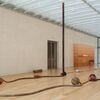In Sprawling Panels, Ethiopian Artist Elias Sime Recycles the First World’s Circuit Boards
Installation view of Elias Sime at James Cohan Gallery, 2015. Photo by Adam Reich.
These days, tech companies make upgrading to the latest cell phone or laptop so seamless—often with just the swipe of a button—that it’s easy to disregard the complex production procedures behind these advancements. But while wires, batteries, and circuit boards are usually tucked neatly inside glass and aluminum cases (out of sight, out of mind), Elias Sime makes a point of turning technology inside out. In his latest show at James Cohan Gallery, the Ethiopian artist makes visible both the hardware and the hard-to-stomach consequences of the first world’s wanton electronics consumption.
Born in Addis Ababa, Ethiopia, and raised during the country’s decade-plus period of Communist rule, Sime followed the unlikely path of becoming an artist in an environment where the title was mainly associated with craftspeople. When Sime graduated from art school in 1990, Ethiopia was in the throes of political and economic turmoil. So, with limited resources available, Sime began assembling artworks from assorted refuse. His ever-replenishing source was—and is—the Merkato, a sprawling open-air market, the biggest on the continent, where hundreds of vendors hawk objects passed down a long line of global trade. These beat-up relics of Western consumerism become, under Sime’s hand, malleable and beloved materials. Combining bottle caps, buttons, and discarded clothing, he constructs large, colorful collages that reflect the realities of day-to-day life faced by his fellow Ethiopians.
Past exhibitions have seen Sime experiment with a variety of materials, ranging from clay figurines to the horns of butchered cattle. And while the 12 works in this exhibition are made primarily from inorganic materials—electrical wires, cords, and computer fragments—they’re not without a life of their own. Tightrope 9 (2009), which stretches almost 20 feet and is one of the show’s many expansive pieces, recalls a landscape seen from miles above, where buffed metal meanders through a countryside of circuit boards. Here, Sime transforms individual, broken objects into a life-giving landscape—a process that mirrors the creative reuse of waste at the Merkato, where oil drums and tin cans are repurposed as vessels for water or food.
There is a buoyancy to Sime’s works, seen most clearly in two vibrant pieces that appear to cover the entire color spectrum. The massive panels are layered with electrical wires of every hue, coiled and braided into bold, spiraling patterns that are then segmented into squares. (Sime says that he treats the discarded objects “like oil paint, acrylic, or clay.”) From afar, they resemble traditional Ethiopian tapestries; up close, they look like exuberant electrical networks.
But the electronic odds and ends gathered from Ethiopian markets weren’t made there. Most hail from Western countries and represent the profusion of waste left behind by an accelerated consumer culture. By stitching together objects that originated from countries around the world, but that he sourced not far from his Addis Ababa home, Sime speaks to the troubled relationship between the countries that create tremendous amounts of e-waste and those that process it.
“Elias Sime” is on view at James Cohan Gallery, New York, Sep. 10–Oct. 17, 2015




